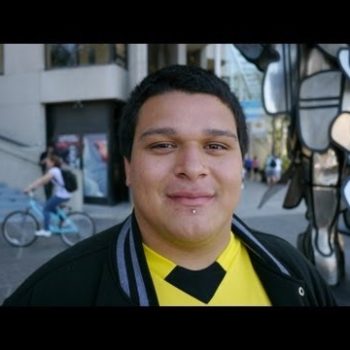When Systems Fail: Bay Street, Toronto, 2012
It is a blustery winter night on the streets of Toronto. Heat rises up from the grate on Bay Street where 16-year-old Robert McLeod tries to catch a few winks of sleep without freezing to death. He doesn’t care for the shelter. He’s tired of being robbed of his possessions when he tries to sleep there. So he sees this grate as an alternative to the harsh conditions inside, despite the biting cold, the constant police harassment, and the unending sense of being ignored … by the entire world.
At some point in 2012, Robert adopts his first pet rat – a companion to cut the edge off the loneliness. He’s had so many pet rats over the years that by 2015, he’s figured out they live an average of two years.
You’re probably wondering how this could happen. How could a young teen transition into adulthood while residing over a sewer grate with only rats to keep him company in modern day Canada?
Robert McLeod, an Asperger’s syndrome sufferer, is one of many youths failed by Canada’s child welfare services. The primary shortcomings of the welfare system are both structural and systematic. They include components such as:
- Housing instability in foster home and/or group home settings
- Aging out of foster care
- Marginalization
- Abuse inside foster homes or group homes
- Poverty and other forms of structural disadvantage as seen across the country in recent years
Robert McLeod suffers from depression, which could well stem from the aftermath of his abuse. In his heart-wrenching tale of injustice, we learn that his mother went so far as to stop feeding him at one point, adding insult to injury when she tossed his food to the dogs as if to say they deserved to eat more than he did. Narrowly escaping severe abuse, that included starvation and isolation among other horrors, Robert was swiftly transported to a group home in Washago. His stay there ran out when his rent money did.
FACT: 42% of Canada’s Millenials Can’t Afford to Move Out of Their Parent’s Homes
Yet youth who are supposed to be protected by the child welfare system are expected to pay rent at 16, sometimes younger. With almost half of Canada’s 20- to 34-year-olds sticking around at mom and dad’s house due to lack of affordable housing alternatives, the expectations for youths in the system are simply unrealistic, to the point of being downright inhumane.
When you take into consideration the likelihood that child welfare youths have already survived some form of abuse (likely at the hands of their own parents), it’s easy to see this is a foundation for disaster. The real proof is now in the numbers, thanks to Without a Home: The National Youth Homelessness Survey, a study conducted by The Canadian Observatory on Homelessness Press and authored by Stephen Gaetz, Bill O’Grady, Sean Kidd & Kaitlin Schwan (2016). It’s notable to mention that Canada’s homeless youth were of such little concern in recent years that this is the first study of its kind.
Here’s What We’ve Learned About Canada’s Most Vulnerable Population: Homeless Young People
Approximately 20% of Canada’s homeless population consists of individuals between the ages of 13 and 24. There is a disparaging overrepresentation of young people from Indigenous backgrounds, racially marginalized communities, or the LGBTQ’s population. Additionally, Canada’s homeless young people face a unique sub-set of problems due to their age. Some of the most significant of these include:
- Becoming homeless before the age of 16. This is the case for an astounding 40.1% of Canada’s homeless young people.
- Direct involvement with child protective services. This is true of 73.3% of homeless Canadian youths.
- Bouts of homelessness. 75.9% of Canada’s homeless youth population report having to endure homelessness more than once, with 36.9% becoming homeless five or more times.
Due to their age and vulnerability, young people sleeping rough on the streets of Canada exhibit an increased likelihood for incident. Such incidents include, but aren’t limited to:
- Rape
- Murder
- Theft
- Physical abuse
- Psychological abuse
- Police harassment
- Death due to harsh conditions such as weather or health-related issues
At Least 63% of Young People Homeless on the Streets of Canada Right Now Were
Abused Before They Were Displaced
For many who aren’t homeless, incidents like the ones listed above might serve as real incentives to get off the streets by any necessary means. Sadly though, many of the young people laying their heads on a sewer grate someplace in Canada tonight have become desensitized to even the most severe offenses, having experienced them so many times before.
For homeless youths failed by the system, most of them began seeing child welfare officials at or before the age of eight. By the time they are homeless teenagers, they’ve already died so much inside, they’d rather just disappear.
When asked about being ignored by most who pass him on the Toronto sidewalks, Robert McLeod had this to say:
“I’ve gotten used to it.”
Draining Our Community One Child at A Time
Through young people, we are paving the way for future generations. When the very institutions that were put in place to protect our children miserably fail them, what we get is:
- Poor academic performance due to lack of stable environment
- Health and nutrient deficiencies
- Chronic homelessness
- Addiction
- Depression
- Inflated rates of suicide
- Systematic oppression and victimization
Is this really the stage we wish to set for the future of Canada and/or the world?
Talk to your legislators about the child welfare system and its inexcusable inaction with regards to homeless youth. Let them know you’re taking notes and expecting to see real positive progress today, for the sake of tomorrow.













